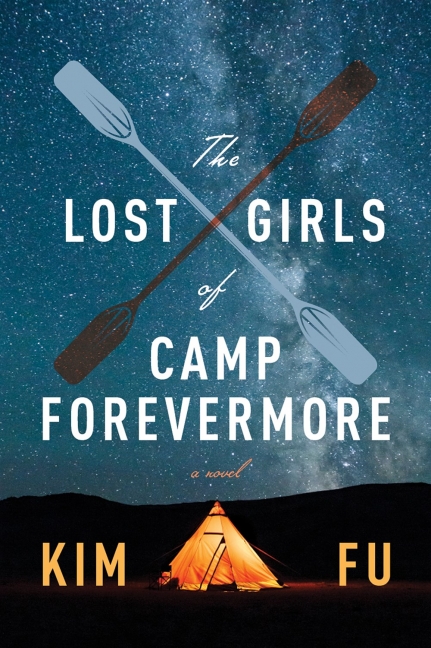
Review of The Lost Girls of Camp Forevermore by Kim Fu
Review by Katie Zdybel
In the opening pages of Kim Fu’s sophomore novel, The Lost Girls of Camp Forevermore, a newly-arrived flock of pre-teen girls gather ceremoniously on the dock to sing the camp anthem: “And I shall love my sisters/for-eve-er-more.”
Next, they paw through a pile of life jackets. Ten-year-old Siobhan Dougherty, one of the book’s five central characters, “snatched one and slid her arms through the holes. Would it reveal her to be too tall, too wide, too infantile, anything other than the universal girl-size implied by the unsorted bins?…Satisfying clicks echoed up and down the dock. By some miracle, no one was left behind.” With the song and the donning of the life jackets, the girls of Camp Forevermore seem to enter into a contract for a particular kind of girlhood — one that honours girlish grit and prepubescent pragmatism, yet ultimately fails to prepare them for any real kind of survival at camp, or in the world that waits for them beyond.
But five of the campers—Siobhan, Nita, Andee, Isabel, and Dina—will be tested far more severely than the rest. When Jan, an elderly camp counselor who cannot let go of the dream of Camp Forevermore, pushes them beyond their capacity, a kayaking adventure becomes a series of horrific mistakes. Each of the girls, ranging in age from nine to twelve, is pushed to the edge of her mental and emotional endurance. Some fare better than others.
The book impresses on multiple levels: Fu is a sentence whiz. She has perfect pitch for phrases that hit the right notes, line by line, paragraph by paragraph. Nothing superfluous nor showy; no throwaway lines. She can sketch a character in a few words, as when Andee, flailing desperately during the swimming test, is introduced.
“When Andee finally swam a little closer, Siobhan could see why: the determined set of her mouth, the ferocity in her eyes. How much she wanted to finish. She would finish, no matter what. It would be cruel to stop her. And more to the point, if they ever were stranded in the ocean, Andee—who had been in the water for what felt like an eternity—would be the last to go down.”
You can read the book entirely for the enjoyment of Fu’s sentence skills and her ability to dive like a jackknife, deeply and sharply into character. But there is also an impressive architecture these sentences build toward. Fu chooses to move both back and forth from the girls’ infamous summer at Camp Forevermore to their adult lives, where the trauma they collectively experienced reverberates in their choice of partners, families, education, and careers. Furthermore, Fu gives each girl, or the woman they become, equal opportunity to narrate. Always in third person, Fu slides from one girl’s head to the next, looking back at Camp Forevermore from a slightly new angle, illuminating different interpretations of the disaster, and then pulling away from that summer completely, and looking instead, straight ahead.
As we follow each girl into womanhood, the past trauma remains subterranean, yet we feel it there, changing the texture of their emotions and interactions. The backstory of Camp Forevermore, the entirety of the traumatic experience, is not fully revealed until the last few pages of the book. As the last puzzle piece is snapped into place, the adult choices of the five girls suddenly become clearer. It is a challenging, complex construction of story. Like throwing a stone into a pond, then shifting focus to the concentric rings that appear and continue to expand outward, while never being quite able to forget the stone, or wanting to retrieve it.
Of course, we never can retrieve the stone. It sinks into blackness just as something is forever lost to girls of Camp Forevermore. What’s interesting is placing a finger on what exactly has been lost for each girl, and why they have lost it. The camp tragedy itself is only an accident—it’s each girl’s handling of the tragedy that produces trauma. Fu proposes that young girls are capable of cruelty, if survival is at stake. At times, this theory feels untrue to life—more thriller or horror than realist fiction. As someone who has worked as both camp counselor and elementary school teacher, I’ve more often been surprised at the instinctive humanity and intuitive kindness young people exude. It is my belief that cruelty is more often learned than it is inherent. And none of the main characters of this story come from a background where violence or cruelty has been taught. That they are quick to act as though they have, feels wayward to me, and also like an opportunity lost. I feel that most adults could unlearn their own selfishness and meanness by observing how children and preteens interact with one another and if Fu had wanted to, she could have ventured down a completely different path with these five girls—one which would explore the ingenuity and deep humanity of young people.
However, this is Fu’s story, exquisitely told, and also Siobhan’s, Nita’s, Andee’s, Isabel’s, and Dina’s. That Fu sees the authenticity in their choices, I have no doubt. There is a confidence and conviction to Fu’s writing that imprints on the reader. Her characters make their own choices and—my stubbornly optimistic views on young people aside—they suffer the consequences infinitely. The echoes of their choices reverberate hauntingly—like a chorus of girls singing a camp anthem across a deep, black lake—throughout the rest of their lives and ours.
Katie Zdybel’s writing has been awarded The New Quarterly’s 2018 Peter Hinchcliffe Short Fiction Award, two Yukon Advanced Artist Awards, and the 2017 UBC Brissenden Scholarship in Creative Writing. She is currently working on her first novel.